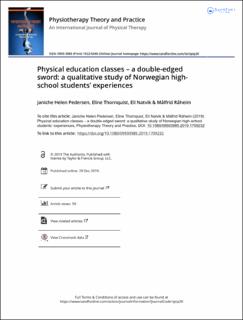| dc.contributor.author | Pedersen, Janiche Helen | |
| dc.contributor.author | Thornquist, Eline | |
| dc.contributor.author | Natvik, Eli | |
| dc.contributor.author | Råheim, Målfrid | |
| dc.coverage.spatial | Norway | en_US |
| dc.date.accessioned | 2020-02-20T08:58:35Z | |
| dc.date.available | 2020-02-20T08:58:35Z | |
| dc.date.created | 2019-12-30T14:25:20Z | |
| dc.date.issued | 2019 | |
| dc.identifier.citation | Pedersen, J. H., Thornquist, E., Natvik, E., & Råheim, M. (2019). Physical education classes – a double-edged sword: A qualitative study of Norwegian high-school students’ experiences. Physiotherapy Theory and Practice, 1-15. | en_US |
| dc.identifier.issn | 0959-3985 | |
| dc.identifier.uri | https://hdl.handle.net/11250/2642755 | |
| dc.description.abstract | Aim: The aim of this study was to explore students’ experiences of physical education (PE) and to gain insight into what contributes to engaging them in PE.
Methods: A total of 316 second-year high-school students from five schools participated by completing a school assignment. The data were analyzed according to content analysis. Findings: Two main themes were developed. The first was One-sided emphasis on performance, bodily skills, and assessment with the corresponding sub-themes: Skills and performance; and Assessment, tests, and grading. The second was Wish for play, respite, co-determination, and togetherness with the sub-themes: Play and spontaneity; Respite, Togetherness and cooperation; and Co-determination and engagement. Our findings reveal a wide range of student experiences with PE classes, from a welcome respite in an otherwise sedentary and theoretically dominated day at school and enjoying being physically active with classmates, to frustration about extensive use of tests, lack of mastery, and feelings of exclusion.
Conclusion: To be consistent with the values of the Ministry of Education in Norway, we conclude that the content and mode of delivery of PE in schools would benefit from being rethought if the intent is to facilitate children to stay physically active. Norwegian physiotherapists are promoters of health and physical activity across the lifespan. As part of health services in schools, they are in a prime position to optimize the PE experience for students. | en_US |
| dc.language.iso | eng | en_US |
| dc.publisher | Taylor & Francis | en_US |
| dc.rights | Attribution-NonCommercial-NoDerivatives 4.0 Internasjonal | * |
| dc.rights.uri | http://creativecommons.org/licenses/by-nc-nd/4.0/deed.no | * |
| dc.subject | curriculum intentions | en_US |
| dc.subject | engagement | en_US |
| dc.subject | influential discursive perspectives | en_US |
| dc.subject | physical education | en_US |
| dc.subject | students’ experiences | en_US |
| dc.title | Physical education classes – a double-edged sword: a qualitative study of Norwegian high-school students’ experiences | en_US |
| dc.type | Peer reviewed | en_US |
| dc.type | Journal article | en_US |
| dc.description.version | publishedVersion | en_US |
| dc.rights.holder | © 2019 The Author(s). | en_US |
| dc.source.journal | Physiotherapy Theory and Practice | en_US |
| dc.identifier.doi | https://doi.org/10.1080/09593985.2019.1709232 | |
| dc.identifier.cristin | 1764400 | |
| cristin.unitcode | 203,11,2,0 | |
| cristin.unitcode | 203,11,1,0 | |
| cristin.unitname | Institutt for helse og funksjon | |
| cristin.unitname | Institutt for helse- og omsorgsvitskap | |
| cristin.ispublished | true | |
| cristin.qualitycode | 2 | |

